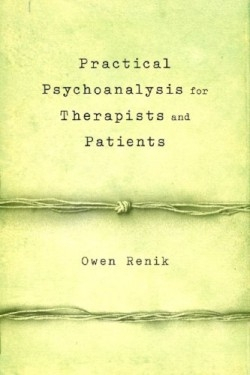Practical Psychoanalysis for Therapists and Patients
- 2006 INDIES Winner
- Bronze, Psychology (Adult Nonfiction)
This couchbuster could be the tipping point for a second Freudian revolution. The first began in the privacy of a Viennese consulting room, where Sigmund Freud’s patient Anna O. coined the term “talking cure.” In a few decades, that invention—a new kind of conversation—changed the consciousness of whole civilizations. Yet patients’ lives, all lives, still defy neat explanation even by Freud’s ingenious theories.
The author, a psychiatrist and respected teaching analyst in San Francisco and editor of The Psychoanalytic Quarterly for a decade, has the credentials to make his practical, humane approach credible to his colleagues. He distills his professional and personal experience with a comfortable balance of assurance and humility. Patients will love it, progressive analysts will embrace him, conservatives will distance themselves. Renik shows how Freud’s authoritarian process of putting the patient on the couch and under a microscope has evolved into a new cooperative model of exploring personal history and present relationships. Caring, searching, and spontaneous interaction takes the place of formulaic explanation in treatment and works much better than the old way.
The book has twenty chapters, each illustrated by a compact case or two. Technical terms and psychoanalytic theory are clarified without condescension for lay readers.
Renik insists that therapy is a mutual learning process in which symptom relief is the best measure of success. Informed patients change the way healers behave. Good doctors learn from their patients, who are the final authorities on what is helpful. Renik admits, without apology, that analysts often fly blind: “much of the learning that produces therapeutic benefit takes place through interactions between patient and analyst that are not necessarily discussed, or even consciously identified.” The patient has to be a collaborator, not a specimen; the therapist must be capable of honest reporting of feelings about what is going on. In their meeting the therapist is a human being who cannot have complete objectivity or total self-awareness, much less be a blank screen. Both parties must welcome the unexpected and deal with it in a disciplined, caring fashion, thus, “collaboration between analyst and patient depends upon the analyst playing his or her cards face up.”
This book should shake up the Freudian establishment, as it empowers patients and their advocates. Historians of psychoanalysis will hear echoes of Otto Rank, Harry Stack Sullivan, Clara Thompson, Carl Rogers, Rollo May, and Irvin Yalom. Here they come home to roost, if not to crow. It takes an Owen Renik to do this, as it took Richard Nixon to open the door to China where others could only wait, or knock in frustration. The ghost of Sigmund Freud will probably nod his approval.
Reviewed by
E. James Lieberman
Disclosure: This article is not an endorsement, but a review. The publisher of this book provided free copies of the book to have their book reviewed by a professional reviewer. No fee was paid by the publisher for this review. Foreword Reviews only recommends books that we love. Foreword Magazine, Inc. is disclosing this in accordance with the Federal Trade Commission’s 16 CFR, Part 255.

